Processor Socket
Intel and AMD have created a set of socket and slot designs for their processors. Each socket or slot is designed to support a different range of original and upgrade processors. Sockets 1, 2, 3, and 6 are 486 processor sockets and are shown together in Figure 1 so you can see the overall size comparisons and pin arrangements between these sockets.
Sockets 4, 5, 7, and 8 are Pentium and Pentium Pro processor sockets and are shown together in Figure 2 so you can see the overall size comparisons and pin arrangements between these sockets.
486 processor sockets.

Pentium and Pentium Pro processor sockets.
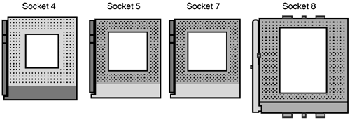
Zero Insertion Force
When the Socket 1 specification was created, manufacturers realized that if users were going to upgrade processors, they had to make the process easier. The socket manufacturers found that 100 lbs. of insertion force is required to install a chip in a standard 169-pin screw Socket 1 motherboard.
With this much force involved, you easily could damage either the chip or the socket during removal or reinstallation. Because of this, some motherboard manufacturers began using low insertion force (LIF) sockets, which required only 60 lbs. of insertion force for a 169-pin chip.
With the LIF or standard socket, I usually advise removing the motherboard—that way you can support the board from behind when you insert the chip. Pressing down on the motherboard with 60–100 lbs. of force can crack the board if it is not supported properly.
A special tool is also required to remove a chip from one of these sockets. As you can imagine, even the low insertion force was relative, and a better solution was needed if the average person was ever going to replace his CPU.
Manufacturers began using ZIF sockets in Socket 1 designs, and all processor sockets from Socket 2 and higher have been of the ZIF design. ZIF is required for all the higher-density sockets because the insertion force would simply be too great otherwise.
ZIF sockets almost eliminate the risk involved in installing or removing a processor because no insertion force is necessary to install the chip and no tool is needed to extract one. Most ZIF sockets are handle-actuated: You lift the handle, drop the chip into the socket, and then close the handle. This design makes installing or removing a processor an easy task.
Socket 1
The original OverDrive socket, now officially called Socket 1, is a 169-pin PGA socket. Motherboards that have this socket can support any of the 486SX, DX, and DX2 processors and the DX2/OverDrive versions. This type of socket is found on most 486 systems that originally were designed for OverDrive upgrades.
Intel Socket 1 pinout.
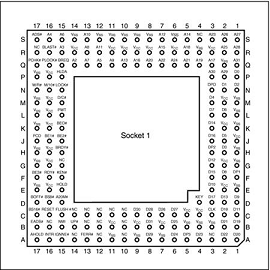
The original DX processor draws a maximum 0.9 amps of 5V power in 33MHz form (4.5 watts) and a maximum 1 amp in 50MHz form (5 watts). The DX2 processor, or OverDrive processor, draws a maximum 1.2 amps at 66MHz (6 watts).
This minor increase in power requires only a passive heatsink consisting of aluminum fins that are glued to the processor with thermal transfer epoxy. Passive heatsinks don't have any mechanical components like fans. Heatsinks with fans or other devices that use power are called active heatsinks. OverDrive processors rated at 40MHz or less do not have heatsinks.
Socket 2
When the DX2 processor was released, Intel was already working on the new Pentium processor. The company wanted to offer a 32-bit, scaled-down version of the Pentium as an upgrade for systems that originally came with a DX2 processor. Rather than just increasing the clock rate, Intel created an all-new chip with enhanced capabilities derived from the Pentium.
The chip, called the Pentium OverDrive processor, plugs into a processor socket with the Socket 2 or Socket 3 design. These sockets hold any 486 SX, DX, or DX2 processor, as well as the Pentium OverDrive. Because this chip is essentially a 32-bit version of the (normally 64-bit) Pentium chip, many have taken to calling it a Pentium-SX.
It was available in 25/63MHz and 33/83MHz versions. The first number indicates the base motherboard speed; the second number indicates the actual operating speed of the Pentium OverDrive chip. As you can see, it is a clock-multiplied chip that runs at 2.5 times the motherboard speed.
238-pin Intel Socket 2 configuration.
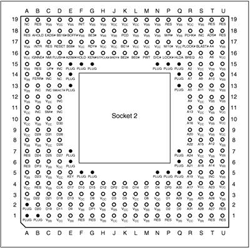
Notice that although the new chip for Socket 2 is called Pentium OverDrive, it is not a full-scale (64-bit) Pentium. Intel released the design of Socket 2 a little prematurely and found that the chip ran too hot for many systems. The company solved this problem by adding a special active heatsink to the Pentium OverDrive processor. ]
This active heatsink is a combination of a standard heatsink and a built-in electric fan. Unlike the aftermarket glue-on or clip-on fans for processors that you might have seen, this one actually draws 5V power directly from the socket to drive the fan. No external connection to disk drive cables or the power supply is required.
The fan/heatsink assembly clips and plugs directly into the processor and provides for easy replacement if the fan fails. Another requirement of the active heatsink is additional clearance—no obstructions for an area about 1.4'' off the base of the existing socket to allow for heatsink clearance.
The Pentium OverDrive upgrade is difficult or impossible in systems that were not designed with this feature. Another problem with this particular upgrade is power consumption. The 5V Pentium OverDrive processor draws up to 2.5 amps at 5V (including the fan) or 12.5 watts, which is more than double the 1.2 amps (6 watts) drawn by the DX2 66 processor.
Socket 3
Because of problems with the original Socket 2 specification and the enormous heat the 5V version of the Pentium OverDrive processor generates, Intel came up with an improved design. The new processor is the same as the previous Pentium OverDrive processor.
Except that it runs on 3.3V and draws a maximum 3.0 amps of 3.3V (9.9 watts) and 0.2 amp of 5V (1 watt) to run the fan—a total of 10.9 watts. This configuration provides a slight margin over the 5V version of this processor. The fan is easy to remove from the OverDrive processor for replacement, should it ever fail.
Intel had to create a new socket to support both the DX4 processor, which runs on 3.3V, and the 3.3V Pentium OverDrive processor. In addition to the new 3.3V chips, this new socket supports the older 5V SX, DX, DX2, and even the 5V Pentium OverDrive chip. The design, called Socket 3, is the most flexible upgradeable 486 design.
237-pin Intel Socket 3 configuration.
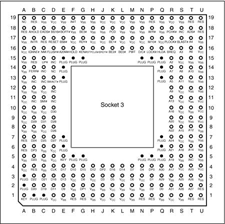
Notice that Socket 3 has one additional pin and several others plugged in compared with Socket 2. Socket 3 provides for better keying, which prevents an end user from accidentally installing the processor in an improper orientation.
However, one serious problem exists: This socket can't automatically determine the type of voltage that is provided to it. You will likely find a jumper on the motherboard near the socket to enable selecting 5V or 3.3V operation.
Socket 4
Socket 4 is a 273-pin socket designed for the original Pentium processors. The original Pentium 60MHz and 66MHz version processors had 273 pins and plugged into Socket 4. It is a 5V-only socket because all the original Pentium processors run on 5V. This socket accepts the original Pentium 60MHz or 66MHz processor and the OverDrive processor.
273-pin Intel Socket 4 configuration.
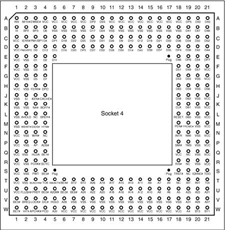
Somewhat amazingly, the original Pentium 66MHz processor consumes up to 3.2 amps of 5V power (16 watts), not including power for a standard active heatsink (fan). The 66MHz OverDrive processor that replaced it consumes a maximum 2.7 amps (13.5 watts), including about 1 watt to drive the fan.
Even the original 60MHz Pentium processor consumes up to 2.91 amps at 5V (14.55 watts). It might seem strange that the replacement processor, which is twice as fast, consumes less power than the original, but this has to do with the manufacturing processes used for the original and OverDrive processors.
Although both processors run on 5V, the original Pentium processor was created with a circuit size of 0.8 micron, making that processor much more power-hungry than the 0.6-micron circuits used in the OverDrive and the other Pentium processors. Shrinking the circuit size is one of the best ways to decrease power consumption.
Although the OverDrive processor for Pentium-based systems draws less power than the original processor, additional clearance might have to be allowed for the active heatsink assembly that is mounted on top. As in other OverDrive processors with built-in fans, the power to run the fan is drawn directly from the chip socket, so no separate power-supply connection is required. Also, the fan is easy to replace should it ever fail.
Socket 5
When Intel redesigned the Pentium processor to run at 75MHz, 90MHz, and 100MHz, the company went to a 0.6-micron manufacturing process and 3.3V operation. This change resulted in lower power consumption: only 3.25 amps at 3.3V (10.725 watts). Therefore, the 100MHz Pentium processor used far less power than even the original 60MHz version. This resulted in lower power consumption and enabled the extremely high clock rates without overheating.
The Pentium 75 and higher processors actually have 296 pins, although they plug into the official Intel Socket 5 design, which calls for a total of 320 pins. The additional pins are used by the Pentium OverDrive for Pentium processors. This socket has the 320 pins configured in a staggered PGA, in which the individual pins are staggered for tighter clearance.
Several OverDrive processors for existing Pentiums were available. These usually were later design chips with integral voltage regulators to enable operating on the higher voltages the older chips originally required. Intel no longer sells these; however, companies such as Evergreen and PowerLeap do still sell upgrade chips for older systems.
320-pin Intel Socket 5 configuration.
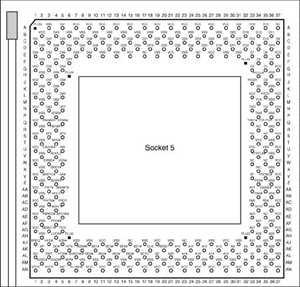
The Pentium OverDrive for Pentium processors has an active heatsink (fan) assembly that draws power directly from the chip socket. The chip requires a maximum 4.33 amps of 3.3V to run the chip (14.289 watts) and 0.2 amp of 5V power to run the fan (one watt), which results in a total power consumption of 15.289 watts. This is less power than the original 66MHz Pentium processor requires, yet it runs a chip that is as much as four times faster!
Socket 6
The last 486 socket was designed for the 486 DX4 and the 486 Pentium OverDrive processor. Socket 6 was intended as a slightly redesigned version of Socket 3 and had an additional 2 pins plugged for proper chip keying. Socket 6 has 235 pins and accepts only 3.3V 486 or OverDrive processors. Although Intel went to the trouble of designing this socket, it never was built or implemented in any systems. Motherboard manufacturers instead stuck with Socket 3.
Socket 7 (and Super7)
Socket 7 is essentially the same as Socket 5 with one additional key pin in the opposite inside corner of the existing key pin. Socket 7, therefore, has 321 pins total in a 21x21 SPGA arrangement. The real difference with Socket 7 is not with the socket itself, but with the companion voltage regulator module (VRM) circuitry on the motherboard that must accompany it.
The VRM is either a small circuit board or a group of circuitry embedded in the motherboard that supplies the proper voltage level and regulation of power to the processor. The main reason for the VRM is that Intel and AMD wanted to drop the voltages the processors would use from the 3.3V or 5V supplied to the motherboard by the power supply.
Rather than require custom power supplies for different processors, the VRM converts the 3.3V or 5V to the proper voltage for the particular CPU you are using. Intel released different versions of the Pentium and Pentium-MMX processors that ran on 3.3V (called VR), 3.465V (called VRE), or 2.8V.
Equivalent processors from AMD, Cyrix, and others used voltages from 3.3V to 1.8V. Because of the variety of voltages that might be required to support different processors, most motherboard manufacturers started including VRM sockets or building adaptable VRMs into their Pentium motherboards.
Socket 7 (Pentium) pinout (top view).
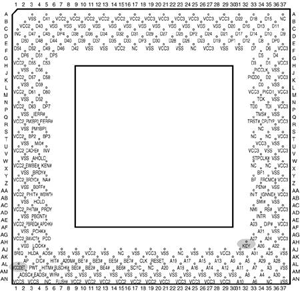
AMD, along with Cyrix and several chipset manufacturers, pioneered an improvement or extension to the Intel Socket 7 design called Super Socket 7 (or Super7), taking it from 66MHz to 95MHz and 100MHz. This enabled faster Socket 7–type systems to be made, supporting processors up to 500MHz, which are nearly as fast as some of the newer Slot 1– and Socket 370–type systems using Intel processors.
Super7 systems also have support for the AGP video bus, as well as Ultra DMA hard disk controllers and advanced power management. Major third-party chipset suppliers—including Acer Laboratories, Inc. (ALi); VIA Technologies; and Silicon Integrated Systems (SiS)—all released chipsets for Super7 boards. Most of the major motherboard manufacturers made Super7 boards in both Baby-AT and ATX form factors.
Socket 8
Socket 8 is a special SPGA socket featuring a whopping 387 pins! This was specifically designed for the Pentium Pro processor with the integrated L2 cache. The additional pins are to enable the chipset to control the L2 cache integrated in the same package as the processor.
Socket 8 (Pentium Pro) pinout showing power pin locations.
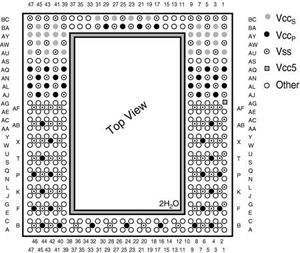
Socket 370 (PGA-370)
In January 1999, Intel introduced a new socket for P6 class processors. The socket was called Socket 370 or PGA-370 because it has 370 pins and originally was designed for lower-cost PGA versions of the Celeron and Pentium III processors. Socket 370 was originally designed to directly compete in the lower-end system market along with the Super7 platform supported by AMD and Cyrix.
However, Intel later used it for the Pentium III processor. Initially all the Celeron and Pentium III processors were made in SECC or SEPP format. These are essentially circuit boards containing the processor and separate L2 cache chips on a small board that plugs into the motherboard via Slot 1.
This type of design was necessary when the L2 cache chips were made a part of the processor but were not directly integrated into the processor die. Intel did make a multiple-die chip package for the Pentium Pro, but this proved to be a very expensive way to package the chip, and a board with separate chips was cheaper, which is why the Pentium II looks different from the Pentium Pro.
Starting with the Celeron 300A processor introduced in August 1998, Intel began combining the L2 cache directly on the processor die; it was no longer in separate chips. With the cache fully integrated into the die, there was no longer a need for a board-mounted processor.
Because it costs more to make a Slot 1 board or cartridge-type processor instead of a socketed type, Intel moved back to the socket design to reduce the manufacturing cost—especially with the Celeron, which at that time was competing on the low end with Socket 7 chips from AMD and Cyrix.
The Celeron was gradually shifted over to PGA-370, although for a time both were available. All Celeron processors at 333MHz and lower were available only in the Slot 1 version. Celeron processors from 366MHz to 433MHz were available in both Slot 1 and Socket 370 versions; all Celeron processors from 466MHz and up through 1.4GHz are available only in the Socket 370 version.
Starting in October 1999, Intel also introduced Pentium III processors with integrated cache that plug into Socket 370. These use a packaging called flip chip pin grid array (FC-PGA), in which the raw die is mounted on the substrate upside down. The slot version of the Pentium III was more expensive and no longer necessary because of the on-die L2 cache.
Note that because of some voltage changes and one pin change, many original Socket 370 motherboards do not accept the later FC-PGA Socket 370 versions of the Pentium III and Celeron. Pentium III processors in the FC-PGA form have two RESET pins and require VRM 8.4 specifications.
Prior motherboards designed only for the older versions of the Celeron are referred to as legacy motherboards, and the newer motherboards supporting the second RESET pin and VRM 8.4 specification are referred to as flexible motherboards. Contact your motherboard or system manufacturer for information to see whether your socket is the flexible version.
Some motherboards, such as the Intel CA810, do support the VRM 8.4 specifications and supply proper voltage, but without Vtt support the Pentium III processor in the FC-PGA package will be held in RESET#. The last versions of the Pentium III and Celeron III use the Tualatin core design, which also requires a revised socket to operate.
Motherboards that can handle Tualatin-core processors are known as Tualatin-ready and use different chipsets from those not designed to work with the Tualatin-core processor. Companies that sell upgrade processors offer products that enable you to install a Tualatin-core Pentium III or Celeron III processor into a motherboard that lacks built-in Tualatin support.
Installing a Pentium III processor in the FC-PGA package into an older motherboard is unlikely to damage the motherboard. However, the processor itself could be damaged. Pentium III processors in the 0.18-micron process operate at either 1.60V or 1.65V, whereas the Intel Celeron processors operate at 2.00V.
The motherboard could be damaged if the motherboard BIOS fails to recognize the voltage identification of the processor. Contact your PC or motherboard manufacturer before installation to ensure compatibility. A motherboard with a Slot 1 can be designed to accept almost any Celeron, Pentium II, or Pentium III processor.
To use the socketed Celerons and Pentium III processors, several manufacturers have made available a low-cost slot-to-socket adapter sometimes called a slot-ket. This is essentially a Slot 1 board containing only a Socket 370, which enables you to use a PGA processor in any Slot 1 board.
Socket 423
Socket 423 is a ZIF-type socket introduced in November 2000 for the original Pentium 4. Socket 423 supports a 400MHz processor bus, which connects the processor to the Memory Controller Hub (MCH), which is the main part of the motherboard chipset and similar to the North Bridge in earlier chipsets.
Pentium 4 processors up to 2GHz were available for Socket 423; all faster versions require Socket 478 instead. Socket 423 uses a unique heatsink mounting method that requires standoffs attached either to the chassis or to a special plate that mounts underneath the motherboard.
This was designed to support the weight of the larger heatsinks required for the Pentium 4. Because of this, many Socket 423 motherboards require a special chassis that has the necessary additional standoffs installed. Fortunately, the need for these standoffs was eliminated with the newer Socket 478 for Pentium 4 processors.
The processor uses five voltage ID (VID) pins to signal the VRM built into the motherboard to deliver the correct voltage for the particular CPU you install. This makes the voltage selection completely automatic and foolproof. Most Pentium 4 processors for Socket 423 require 1.7V. A small triangular mark indicates the pin-1 corner for proper orientation of the chip.
Socket 478
Socket 478 is a ZIF-type socket for the Pentium 4 and Celeron 4 (Celerons based on the Pentium 4 core) introduced in October 2001. It was specially designed to support additional pins for future Pentium 4 processors and speeds over 2GHz. The heatsink mounting is different from the previous Socket 423, allowing larger heatsinks to be attached to the CPU.
Socket 478 supports a 400MHz, 533MHz, or 800MHz processor bus that connects the processor to the memory controller hub (MCH), which is the main part of the motherboard chipset. Socket 478 uses a new heatsink attachment method that clips the heatsink directly to the motherboard, and not the CPU socket or chassis (as with Socket 423).
Therefore, any standard chassis can be used, and the special standoffs used by Socket 423 boards are not required. The new heatsink attachment allows for a much greater clamping load between the heatsink and processor, which aids cooling.
Socket 478 processors use five VID pins to signal the VRM built into the motherboard to deliver the correct voltage for the particular CPU you install. This makes the voltage selection completely automatic and foolproof. A small triangular mark indicates the pin-1 corner for proper orientation of the chip.
Socket A (Socket 462)
AMD introduced Socket A, also called Socket 462, in June 2000 to support the PGA versions of the Athlon and Duron processors. It is designed as a replacement for Slot A used by the original Athlon processor.
Because the Athlon has now moved to incorporate L2 cache on-die, and the new low-cost Duron is available only in an on-die cache version, there was no longer a need for the expensive cartridge packaging the original Athlon processors used. Socket A has 462 pins and 11 plugs oriented in an SPGA form.
Socket A has the same physical dimensions and layout as Socket 370; however, the location and placement of the plugs prevent Socket 370 processors from being inserted. Socket A supports 32 voltage levels from 1.100V to 1.850V in 0.025V increments, controlled by the VID0-VID4 pins on the processor. The automatic voltage regulator module circuitry typically is embedded on the motherboard.
After the introduction of Socket A, AMD moved all Athlon (including all Athlon XP) processors to this form factor, phasing out Slot A. In addition, for a time AMD also sold a reduced L2 cache version of the Athlon called the Duron in this form factor. The Athlon 64 uses a different processor socket called Socket 754.
Socket 603
Socket 603 is used with the Intel Xeon processor in DP (dual processor) and MP (multiple processor) configurations. These are typically used in motherboards designed for use in network file servers.
Socket 754
Socket 754 is used with the new AMD Athlon 64 processor, which is AMD's first 64-bit processor for desktop computers.